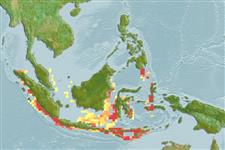>
Eupercaria/misc (Various families in series Eupercaria) >
Nemipteridae (Threadfin breams, Whiptail breams)
Etymology: Nemipterus: Greek, nema, -atos = filament + Greek, pteron = wing, fin (Ref. 45335).
More on author: Bleeker.
Environment: milieu / climate zone / intervalo de profundidade / distribution range
Ecologia
marinhas demersal; não migratória; intervalo de profundidade 50 - 150 m (Ref. 9785). Tropical; 6°N - 11°S, 94°E - 128°E (Ref. 3810)
Indo-West Pacific: southern Indonesia, Sumatra to Flores. This species is very similar to Nemipterus bathybius.
Tamanho / Peso / Idade
Maturidade: Lm ? range ? - ? cm
Max length : 18.0 cm SL macho/indeterminado; (Ref. 3810); common length : 12.0 cm SL macho/indeterminado; (Ref. 3810)
Espinhos dorsais (total) : 10; Raios dorsais moles (total) : 9; Espinhos anais: 3; Raios anais moles: 7. Suborbital spine absent. Preopercle with 3 transverse scale rows. Pectoral fins long, reaching to or almost to level of origin of anal fin. Pelvic fins moderately long, reaching to or just beyond anus. Upper lobe of caudal fin produced into a short trailing filament. A line drawn upwards from the posterior edge of suborbital reaching the dorsal profile 2 to 5 scale rows before origin of dorsal fin. Axillary scale present. Color: Upper body pinkish, pearly white below. Compared to N. bathybius, this has a more or less straight caudal filament; is more slender and differs in color pattern: lower lateral stripe originates from above the pectoral-fin base; dorsal fin lacks undulating yellow lines; and upper caudal fin and filament red-edged.
Body shape (shape guide): fusiform / normal; Cross section: oval.
Occurs on sand or mud bottoms. Rarely seen in less than 50 m depth (Ref. 48635).
Life cycle and mating behavior
Maturidade | Reprodução | Desova | Ovos | Fecundidade | Larvas
Russell, B.C., 1990. FAO Species Catalogue. Vol. 12. Nemipterid fishes of the world. (Threadfin breams, whiptail breams, monocle breams, dwarf monocle breams, and coral breams). Family Nemipteridae. An annotated and illustrated catalogue of nemipterid species known to date. FAO Fish. Synop. 125(12):149p. Rome: FAO. (Ref. 3810)
Categoria na Lista Vermelha da IUCN (Ref. 130435: Version 2025-1)
Ameaça para o homem
Harmless
Utilização humana
Pescarias: pescarias de subsistência
Ferramentas
Relatórios especiais
Descarregue XML
Fontes da internet
Estimates based on models
Preferred temperature (Ref.
123201): 23 - 28.1, mean 25.2 °C (based on 19 cells).
Phylogenetic diversity index (Ref.
82804): PD
50 = 0.5000 [Uniqueness, from 0.5 = low to 2.0 = high].
Bayesian length-weight: a=0.01349 (0.00626 - 0.02905), b=2.96 (2.79 - 3.13), in cm total length, based on LWR estimates for this Genus-body shape (Ref.
93245).
Nível Trófico (Ref.
69278): 3.8 ±0.5 se; based on size and trophs of closest relatives
Resiliência (Ref.
120179): Elevada, tempo mínimo de duplicação da população menor que 15 meses (Preliminary K or Fecundity.).
Fishing Vulnerability (Ref.
59153): Low vulnerability (12 of 100).
🛈
